Of the 104
photographically-documented suicides, why were all but three from the
North Tower? In
the South Tower, people who ignored their supervisor's orders to return
to their desks, people who did not listen to the "no danger, all safe"
intercom announcements were the "take charge" people who took charge of
their own lives and left. In the North Tower, the people who
took fullest charge of their own lives are the ones who jumped.
You may stop here and
consider the rest of this another time. You are in Part 3,
Taking Charge.
People who lost those
they loved in the North Tower have studied
these photographs more than you or I ever will.
They have sought out and sat down at computer monitors with
the original photographers to study images -- iconic or never published
-- to confirm or finish private fears or hope.
Leave them the space to do this.
For some, a jump is only
a suicide, and a suicide is always an act
against God and condemnation to Hell. Leave them a grip on
their honor. Give them their space.
Forcing people to jump
out the windows for relief is the ultimate
failure for building fire safety professionals.
These photographs are the
last
thing building safety analysts, fire control designers and architects
ever want to see. Perhaps that is why our National
Institute
of Standards and Technology (NIST, the former "Bureau of Standards")
has studied all of them that exist to determine the number of jumps
that can be documented -- the time, the floor, even the window to which
people were able to make their way.
Surely anyone can understand why such data must be generated
by looking at photos some of us do not want to see.
Nobody went to work that
day intending to kill themselves. This is not simply suicide.
The people who jumped had to make the biggest
decision of their lives,
and the most private one, and yet do it in public. You and I
have our privacy. Pause in your privacy before condemning
the dead or judging the living. We were not there,
and
we never ever in our lifetimes want to stand at that window.
Other Americans have
tried to prevent fellow Americans from
taking these photographs, have denounced those that displayed
them, have threatened to kill others for displaying a reminder
of them (as art in a gallery).
Most of the following photos have sat on my
hard drive since a Tuesday or Wednesday in a beautifully sunny
September
ten years ago. My country's leaders spent those ten years focusing
political attention and national wealth on the losers of the
globalization race -- al Qaeda, Afghanistan, Pakistan, Iraq.
We squandered blood and treasure on losers while
the winners pulled ahead of us with their dominance in manufacturing,
solar power (Germany, China), education and national infrastructure.
We devoted ourselves to what we do worst -- nation building
-- in areas that matter least, when we should have been concentrating
on nation building in the nation that matters most to all of us: our
own.
With these photos, I will find the courage to face all
that was done to
us on that day. Knowing all that they did to us, facing all
that we have done
to them, I will accept only an honorable and wiser
future for my country.
In this essay, I have drawn on
the
story of
Falling Man, told by Tom Junod with power and
sensitivity:
"The Falling
Man"
by
Tom Junod,
in Esquire Magazine
8 September 2009
I thank Tom Junod for
writing it, and Esquire
Magazine for leaving it on the Internet.
COMPLAINTS
FOR PRINTING IT
After they printed
Richard Drew's photograph above of a falling man, papers all
over the
country, from the Fort Worth Star-Telegram to the
Memphis Commercial Appeal to The Denver Post, were forced to defend
themselves against charges that they exploited a man's death, stripped
him of his dignity, invaded his privacy, turned tragedy into leering
pornography. Most letters of complaint stated the obvious: that someone
seeing the picture had to know who it was. Still, even as Drew's
photograph became at once iconic and impermissible, its subject
remained unnamed.
EVERYONE
IS READY TO TELL
ME WHAT I'M ALLOWED TO SEE OR KNOW
The resistance to the
images of the jumpers started
immediately. There was a mother whispering to her
distraught child a consoling lie: "Maybe they're just birds, honey."
Bill Feehan, second in command at the fire department, chased a
bystander who was panning the jumpers with his video camera, demanding
that he turn it off, bellowing, "Don't you have any human decency?"
before dying himself when the building came down. In the most
photographed and videotaped day in the history of the world, the images
of people jumping were the only images that became, by consensus, taboo
.... Elsewhere, all over the world, people saw the human
stream pour from the
top of the North Tower, but here in the United States, we saw these
images only until the networks turned them off, out of respect for the
families of those so publicly dying. The jumpers' experience,
instead of being central to the horror, became tangential
to it, became a sideshow relegated to the underbelly of the Internet
and best forgotten.
If the
number provided by USA Today is accurate -- 200 suicides by jumping --
then between 7 and 8 percent of those who died in
New York City on September 11, 2001, died by jumping out of the
buildings. If 200 is true for the North Tower, where 1344
were trapped, it means that the ratio is more like one in six
that made this choice.
SUPPRESSION
OF ART
Eric
Fischl, Tumbling
Woman, 2001.
Bronze, 37x74x50 inches. Edition of 5.
The day after Tumbling
Woman was exhibited in New York's Rockefeller
Center, Andrea Peyser of the New York Post denounced it in a column
titled "Shameful Art Attack," in which she argued that Fischl had no
right to ambush grieving New Yorkers with the very distillation of
their own sadness. ... "I was trying to say something about
the way we all feel," Fischl says, "but people thought I was trying to
say something about the way they feel -- that I was trying to take away
something only they possessed."
Fischl, well known for
large figural artworks, sketched hired models
rolling on the floor in preparation for his sculpture (they
were literally tumbling women on an athletic tumbling mat).
He chose the subject in the hopes of returning focus from buildings
coming down back to people -- the human loss.
Jerry
Speyer, a trustee of the Museum of Modern Art who runs
Rockefeller Center, ended the exhibition of Tumbling Woman after a
week. "I pleaded with him not to do it," Fischl says. "I thought that
if we could wait it out, other voices would pipe up and carry the day.
He said, 'You don't understand. I'm getting bomb threats.' I said,
'People who just lost loved ones to terrorism are not going to bomb
somebody.' He said, 'I can't take that chance.' "
This is domestic terrorism. Terrorism, like
rats, like disease, travels with man. It is a part of every
civilization.
A
PASTRY CHEF
AS FALLING MAN An editor at the
Toronto Globe and Mail assigned a reporter named Peter
Cheney to discover the identity of the Falling Man. Cheney at
first despaired of his task...
Then he applied himself, sending the digital photograph to a shop that
clarified and enhanced it....the man was most likely not black but ...
Latino. He wore a goatee. And the white shirt billowing from his black
pants was not a shirt but ... a tunic, the kind of jacket a
restaurant worker wears. Windows on the World, the restaurant at the
top of the North Tower, lost seventy-nine of its employees on September
11, as well as ninety-one of its patrons. Cheney .... walked through
Times Square. It was after midnight, eight days after the attacks. The
missing posters were still everywhere, but Cheney was able to focus on
one that seemed to present itself to him -- a poster portraying a man
who worked at Windows as a pastry chef, who was dressed in a white
tunic, who wore a goatee, who was Latino. His name was Norberto
Hernandez.
He lived in Queens. Cheney took the enhanced print of the Richard Drew
photograph to the family, in particular to Norberto Hernandez's brother
Tino and sister Milagros. They said yes, that was Norberto. Milagros
had watched footage of the people jumping on that terrible morning,
before the television stations stopped showing it. She had seen one of
the jumpers distinguished by the grace of his fall -- by his
resemblance to an Olympic diver -- and surmised that he had to be her
brother. Now she saw, and she knew.
BUT
ARE WE SURE?
Seventy-nine people died on the morning of September 11 after
going to
work at Windows on the World. Another twenty-one died while in the
employ of Forte Food, a catering service that fed the traders at Cantor
Fitzgerald. Many of the dead were Latino, or light-skinned black men,
or Indian, or Arab. Many had dark hair cut short. Many had mustaches
and goatees. Indeed, to anyone trying to figure out the identity of the
Falling Man, the few salient characteristics that can be discerned in
the original series of photographs [there was more than one] raise as
many possibilities as they exclude. There is, however, one fact that is
decisive. Whoever the Falling Man may be, he was wearing a
bright-orange shirt under his white top. It is the one inarguable fact
that the tearing winds of the fall reveals.
Falling Man has also
been identified -- mistakenly -- as Jonathan Briley.
The Daily Nation
Twin
Towers jumpers that Americans will not talk about
By David James Smith
Posted
Saturday, September 10 2011
JIN: About a week after
it was posted, the Nation Media Group removed Smith's article from the
Daily Nation.
I had quoted the
indented paragraphs below. The full text has been saved by
others, & you
can read it here.
I thank David James
Smith for his factual honesty and for sensitive, sympathetic writing.
Some
have incorrectly identified Falling Man as Jonathan Briley, a
43-year-old African American who, like Norberto Hernandez,
worked at the Windows on the World restaurant. Jonathan's
intact body was returned to his family; the fact that the body was
intact tells his sister Gwendolyn that it is a mis-identification.
Their religion leads Norberto Hernandez's wife and immediate family
to believe suicide condemns a person to Hell and they cannot accept
either
the photo identification nor the idea that these were never suicides --
no one wanted to kill themselves, everyone was forced to escape pain in
the only way possible. Gwendolyn has her own pain and wants
only to give others room for theirs. She insists on
nothing. Who were we to judge how anyone would react in that
inferno? Nobody should feel any shame, she says. “They were
falling into the arms of God, they really were.”
Tom
Junod in Esquire
reminds us that Hernandez's wife insisted on not knowing.
But a mother who lost both her sons on September 11
had to know. They worked together at Cantor Fitzgerald. The bond trading company lost 658 of its
960 employees on 9/11, everyone who was at work that day in the North
Tower. . ... The mother called the photographer and asked him
to enlarge and clarify the picture. Demanded that he do it. And then
she knew, or knew as much as it was possible to know. Both of her sons
were in the picture. One was standing in the window, almost brazenly.
The other was sitting inside. She does not need to say what may have
happened next.
"The thing I hold was
that both of my sons were together," she says, her instantaneous tears
lifting her voice an octave. "But I sometimes wonder how long they
knew. They're puzzled, they're uncertain, they're scared -- but when
did they know? When did the moment come when they lost hope? Maybe it
came so quick...."
RICHARD
DREW.
What kind of photographer does it take to do this work, to
generously give time to the bereaved afterwards? When he was
twenty-one years old, Richard Drew was standing right behind
Bobby Kennedy when Bobby Kennedy was shot in the head. Drew's jacket
was spattered with Kennedy's blood, but he jumped on a table and shot
pictures of Kennedy's open and ebbing eyes, and then of Ethel Kennedy
crouching over her husband and begging photographers -- begging him --
not to take pictures.
Although he has preserved the jacket patterned with
Kennedy's blood, Richard Drew has never not taken a
picture, never averted his
eye. He works for the Associated Press. He is a journalist. It is not
up to him to reject the images that fill his frame . . .
FALLING WOMAN - RICHARD AND KAREN
See
MSNBC, July 2006
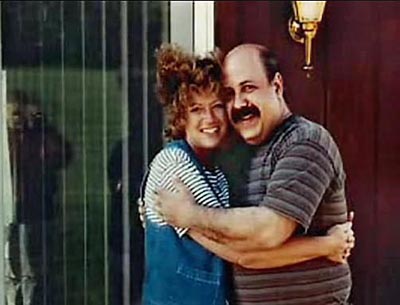 Richard Pecorella saw a photo by
AP photographer Amy Sancetta, showing
a group of people desperately peering from gaping holes high up in the
tower, some trying to get out.
Richard Pecorella saw a photo by
AP photographer Amy Sancetta, showing
a group of people desperately peering from gaping holes high up in the
tower, some trying to get out.
“I saw her,” Pecorella
said. “She
was wearing a blue bandanna, like she did at work to hold her hair
back, and it was her shape. She had on a blue sweater and cream-colored
pants that day.”
As Pecorella went over
photos of
"jumpers" with
photographer Richard Drew, Drew was almost apologetic — his
instincts had just taken over, he said, he had just recorded what was
happening. Pecorella reassured him that, in fact, it
gave him
some
closure to know that, at the end, Karen had made a choice. She had
jumped; she did not, as he said, burn up and become toast.
“She chose
how she should die. It’s not a religious thing with me. A lot of people
have problems because they consider it as suicide, which means you go
to hell, but I don’t consider it like that, I think it’s
more complicated.”
Most families have recovered no more than a fragment of bone,
identified through DNA. "To me, the photo of her falling was
like
finding the body. I thought it was something that would help
me move
on. I needed to know how she died."
Richard met
the woman he calls “the love of my life” on April 26, 1997, at a NASCAR
race in Nazareth, Pa., while both were in the middle of bitter
divorces. Karen Juday, an assembly line worker who lived in Elkhart,
Ind.,
was visiting a brother and Pecorella was at his first NASCAR race, on a
ticket a friend gave him to distract him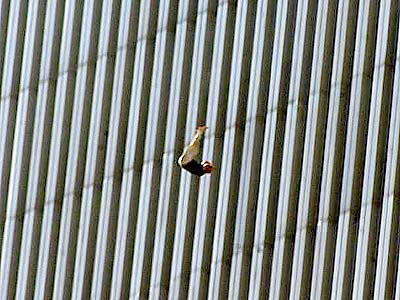 from his troubles. “It was instant magic,” he says
of their first dinner that evening.
from his troubles. “It was instant magic,” he says
of their first dinner that evening.
Six months later,
Karen
had moved into Pecorella’s Brooklyn home and had taken a job with
Cantor Fitzgerald. Each morning, they would drive to his office in
downtown Brooklyn, then she’d take the subway to Manhattan.
“She loved it there. She’d say ’Wow, the planes fly right
past the window!”’ he remembers.
They started planning a
Las Vegas wedding for June 2002.
On Sept. 11, 2001,
Pecorella was sitting at his office desk when the first hijacked plane
hit the north tower. From his [Brooklyn] window, he watched in horror
as the skyscraper disappeared in a mammoth cloud of smoke.“I knew she
was up there.” Co-workers struggled to restrain him
as he rushed from
his desk, screaming . . . .
... he drank himself
into a stupor, “morning, noon and night,” but his employer held his job
for him and he eventually returned to work — and to life ...
One day in the winter of
2002, he scattered Juday’s cremated remains — a single jaw bone found
in the trade center ruins — from the the Verrazano-Narrows Bridge,
which connects Staten Island to Brooklyn — the first place in
the city Karen had seen when they started their lives together.
See:
Ten years later, on the
10th anniversary of 9/11 this month,
David James Smith's
"Twin Towers jumpers that Americans will not talk about"
was removed from the
Internet by The Daily Nation/Nation Media Group less than 10
days after it was posted, but is available
here.
It is OK stop here and
consider the rest of this another time. You are in Part 3,
Taking Charge.
Click
to enlarge. Photo: Jose Jimenez -
Primera Hora /
Getty
Images.
Above: some of 1344 people trapped in the 110 story World Trade
Center's North
Tower
on or above the 93rd to 98th floors.
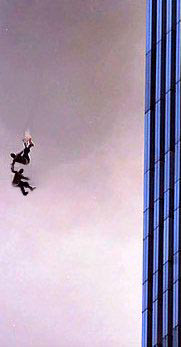
They jumped steadily, from all four sides of the North
Tower, from all floors above and around the impact.
They jumped from the offices of Marsh & McLennan,
the insurance company; from the offices of Cantor Fitzgerald, the
bond-trading company; from Windows on the World, the restaurant on the
106th and 107th floors. For more than an hour and a half,
they streamed from the building, one after another, consecutively, not
en masse, ...
... there were reports that some tried parachuting, before the force of
the wind ripped the drapes, the tablecloths, the desperately
gathered fabric, from their hands. Skydiving velocity was 140
mph, a Category 4 hurricane. If you could hold a vertical
position, your 200 mph terminal velocity reached the highest
wind speeds recorded. Most people did not hold a sky-dive or
a vertical position; they tumbled.
Before the aviation fuel fireball burned itself out, witnesses saw
people groping their way out of black smoke and falling. Did
they not realize the wall was blown out?
Later, people got out of the windows, 100 or more floors up, and began
trying to climb up or down the outside of the building to imagined
safety. ... In all four cases, they soon lost their grip and fell.
Eyewitnesses have described people hugging or holding hands as they
fell in pairs.
The story and
images of 9/11 are very hard for anyone who loves someone to look at.
For fire fighters who save lives, the helplessness was hardest of all.
9-11
20-11
I turn from tireless talk
of heroes.
stand again with all who
never made it.
Back again at
the answering machine.
Calls from the distant
doomed.
The last call they will
ever make.
It's illegal to use your
phone on a flight,
and, boy, they sure were
punished for it.
At 140 miles per hour,
the lungs explode.
Puffs of pink.
For a hundred and two
minutes
Mostly alone, but
sometimes in pairs,
the dull thuds, the puffs
of pink.
"Let's get out of here.
They'll kill you if you
get hit by one."
J. I. Nelson
Sept 11, 2011
top
911 - An Attack by
Political Extremists using Hijacked Airliners
Page 1: Tall
Buildings
Page 2: The
Pile and the
streets
Page 3: Taking
Charge
-- you are here
Page 4: The Pentagon, Pennsylvania
& the Freedom Tower
Pentagon
Pennsylvania
The WTC
site back then
Ground
Plan & Buildings
Freedom Tower
Home page for photo
essay on Hurricane
Katrina
Home page for my
messy,
cluttered Website
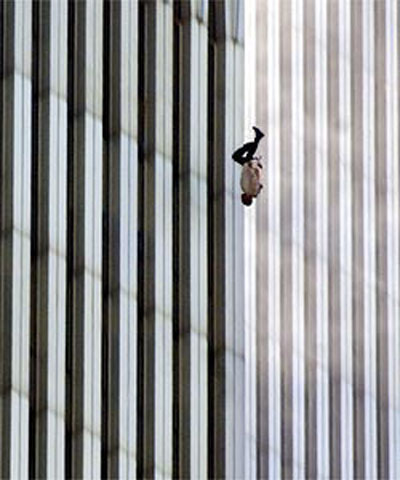 104 jumps are
photographically documented, all but 3 of them from the North Tower,
struck
first but collapsing second. The total
number is probably closer to 200.
104 jumps are
photographically documented, all but 3 of them from the North Tower,
struck
first but collapsing second. The total
number is probably closer to 200. 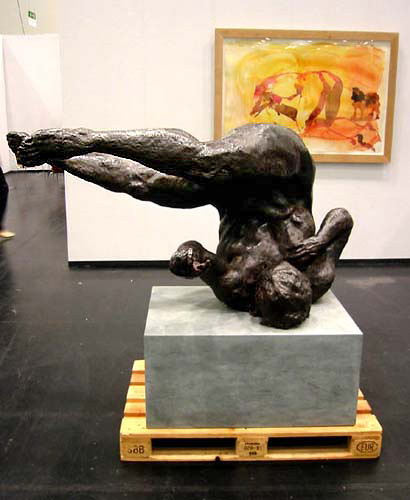
 Richard Pecorella saw a photo by
AP photographer Amy Sancetta, showing
a group of people desperately peering from gaping holes high up in the
tower, some trying to get out.
Richard Pecorella saw a photo by
AP photographer Amy Sancetta, showing
a group of people desperately peering from gaping holes high up in the
tower, some trying to get out. from his troubles. “It was instant magic,” he says
of their first dinner that evening.
from his troubles. “It was instant magic,” he says
of their first dinner that evening.